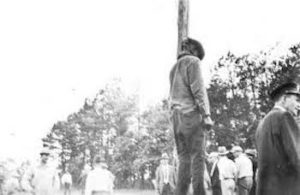
John Carter murdered
*On this date in 1927, another Black man was lynched in Little Rock, Arkansas.
This murder and the rioting that followed are one of the most notorious incidents of racial violence in the state’s history. The experience and wave of mob violence culminated in the lynching of John Carter. This event reveals much about the history of race relations in Little Rock and the state’s struggle with its national image. The episode began on April 30, 1927, when a janitor discovered the dead body of a twelve-year-old white girl named Floella McDonald in the belfry of the First Presbyterian Church in Little Rock.
The next afternoon, police arrested the janitor and his seventeen-year-old mulatto son, Lonnie Dixon, for the murder. Realizing the outrage present in the city, the police secretly transported the Dixons to the Texarkana (Miller County) city jail. This tactic proved prudent, as thousands of people gathered outside the state penitentiary and city hall in Little Rock, determined to seek revenge against the Dixons that night. Although mob activity in the city dissipated over the next few days, tensions over the murder of the girl remained high.
Then, on May 4, a thirty-eight-year-old Black man named John Carter allegedly assaulted a white woman and her daughter near downtown Little Rock. An armed posse searched the countryside for Carter. After finding him later that day, the mob hanged him from a telephone pole and shot him. A caravan of cars then dragged Carter’s mangled corpse through the streets of Little Rock, stopping at the intersection of 9th and Broadway, which was the heart of the city’s Black community at the time. For the next several hours, an estimated 5,000 white people rioted in the intersection and the surrounding neighborhood. Carter’s body was set ablaze, with doors and furniture from neighborhood businesses and churches serving as fuel.
As a result of warnings from the city’s Black leaders, including Scipio A. Jones, no residents ventured into the streets, and further bloodshed was avoided. Three hours after the rioting began, (then) Governor John Martineau deployed the Arkansas National Guard to the scene. Upon arrival, they found a mob member directing traffic with a charred arm broken off of Carter’s body. Soon thereafter, the crowd dispersed. The next day, the police detained a boy on Main Street for selling pictures of John Carter’s lynched body for fifteen cents a copy. Local leaders, including Martineau, newspaper editors, and businessmen, strongly condemned the lynching and rioting.
A grand jury was convened to investigate the incident, but it deadlocked and was dismissed without issuing indictments. The lynching also received immediate coverage from the national media, whose attention was already focused on Arkansas because of the devastating Mississippi River Flood of 1927. Consequently, local leaders were very concerned about damage to the state’s image and the negative impact that the lynching might have on the flood relief efforts. Anxiety continued in Little Rock for the next several weeks.
There were reports that dozens of Black residents fled the city, some leaving the state entirely, and the Board of Censors banned two out-of-state Black newspapers—the Chicago Defender and Pittsburgh Courier—from circulation out of fear that they were inflaming racial tensions. Then, on May 19, with 200 National Guardsmen protecting the courthouse because of bomb threats and rumors of another lynching, Lonnie Dixon was tried and sentenced to death. He was executed one month later. Although it would be over twenty-five years until Little Rock experienced another major episode of racial unrest, the Central High episode, the lynching of John Carter left immediate scars on the city’s residents that would not heal for decades.
Eison, James Reed. “Dead, But She was in a Good Place, a Church.” Pulaski County Historical Review 30 (Summer 1982): 30–42.
Greer, Brian D. “A Flood of Fear: Little Rock and the Lynching of John Carter.” Research Paper. Tom W. Dillard Black Arkansiana Collection. Butler Center for Arkansas Studies, Little Rock, Arkansas.
“The Last Lynching: A New Look at Little Rock’s Last Episode of Deadly Mob Justice.” Arkansas Times. August 4, 2000, pp. 12–19.
Haldeman-Julius, Marcet “The Story of a Lynching: An Exploration of Southern Psychology.” Haldeman-Julius Monthly 6 (August 1927): 3–32, 97–103.
Lewis, Todd. “Mob Justice in the ‘American Congo’: ‘Judge Lynch’ in Arkansas during the Decade after World War I.” Arkansas Historical Quarterly 52 (Summer 1993): 156–184.